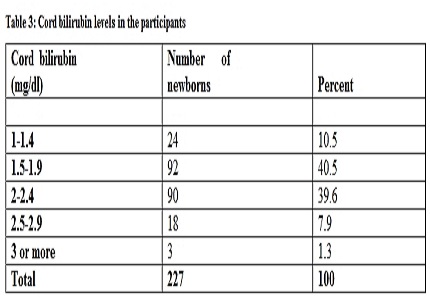Prospective study on cord bilirubin level as a predictor of Hyperbilirubinemia in term healthy neonates
Abstract
Introduction: Neonatal jaundice or hyperbilirubinemia is a cause of concern for parents and pediatricians, with more than 60% being affected by this condition in the first few weeks. Prediction of high risk neonates for hyperbilirubinemia will help in developing appropriate follow-up programs for managing the condition. It will also help in reducing duration of hospital stay for low-risk neonates.
Objective: To estimate the predictive value of umbilical cord blood bilirubin level for the development of significant hyperbilirubinemia in healthy, full term neonates.
Methodology: A prospective study on 450 healthy full tem newborns was undertaken in the postnatal care ward of a tertiary level teaching hospital. The study focused on predictive ability of cord blood bilirubin levels and subsequent development of hyperbilirubinemia.
Results: Clinically significant hyper bilirubinemia was detected in 254 out of 450 newborns (56%) neonates. Majority of participants had cord blood bilirubin levels ranging from 1.5-2.4mg/dl. Only 1.3% (3 neonates) had levels ≥3 mg/dl. Majority of newborns in our study (60%) had an intermediate risk of developing hyper bilirubinemia, and only 1.3% (31) belonged to the high risk category on stratifying risks. Cord bilirubin cut off value of 1.9 mg/dl predicted subsequent hyperbilirubinemia with sensitivity of 91.8% and specificity of 52.4%.
Conclusion: Study highlights that risk stratification is an excellent method of tracking newborns with hyperbilirubinemia as newborns with hour-specific bilirubin value in low risk zone have reduced risk of developing subsequent significant hyperbilirubinemia. The probability of developing this condition in neonates was not significantly different in males and females.
Downloads
References
2. American Academy of Pediatrics. Subcommittee on hyperbilirubinemia. Neonatal jaundice and kernicterus. Pediatrics. 2001;108 (3):763–765.
3. Rosenfeld J. Umbilical cord bilirubin levels as a predictor of subsequent hyperbilirubinemia. J Fam Pract. 1986 Dec;23(6):556-8. [PubMed]
4. Norr KF, NacionK. Outcomes of post partum early discharge.1960-1986, a comparative review. Birth .1987; 14 (3): 135-141.Doi: 10.1111/j.1523-536X.1987.tb01475.x.
5. Bhutani VK, Johnson L, SivieriEM.Predictiveability of a predischargehour-specificserumbilirubin for subsequentsignificanthyperbilirubinemia in healthyterm and near-termnewborns. Pediatrics. 1999 Jan;103(1):6-14. [PubMed]
6. Gregory P, Martin R, Cloherty P. Neonatal Hyperbilirubinemia. In: Cloherty JP, Eichenwald EC, Hansen AR, Stark AR. Editors. Manual of Neonatal Care. 7thed. New Delhi (India). Wolter Kluwer. 2011. p.304.
7. Sun G, Wang YL, Liang JF, Du LZ. [Predictivevalue of umbilical cord bloodbilirubinlevel for subsequentneonatal jaundice]. ZhonghuaErKeZaZhi. 2007 Nov;45(11):848-52. [PubMed]
8. Zeitoun, A, Elhagrasy H, Abdelsatar D. Predictive value of umbilical cord blood bilirubin in neonatal hyperbilirubinemia. Gaz Egypt Paediatr Assoc. 2013; 61(1):23-30.doi: 10.1016/j.epag.2013.04.006.
9. Suchońska B, Wielgoś M, Bobrowska K, Marianowski L. [Concentration of bilirubin in the umbilical blood as an indicator of hyperbilirubinemia in newborns]. Ginekol Pol. 2004 Oct;75(10):749-53. [PubMed]
10. Ahire N, Sonawane R, Gaikwad R, Patil S, and Sonawane T. Study of correlation of cord blood bilirubin with neonatal hyperbilirubinemia. MVP Journal of Medical Sciences. 2016; 3(1): 60-66. Doi: 10.18311/mvpjms/2016/v3/i1/739.
11. Sehgal P, Wasim S, Chandar V, Gupta A, Rawat A, Kalra V, Pandita N, Bhat N. Cord bilirubin levels as a predictive marker forneonatal hyperbilirubinemia: a prospective study. BMR Medicine. 2017; 81(4).
12. Pabbati J. Umbilical cord blood bilirubin as a predictor for neonatal hyperbilirubinemia. Journal of biomedical and pharmaceutical research. 2014; 3(6). Available at:
13. Hamdi N, Elgayar A, Salah H. Cord blood bilirubin as a predictor of neonatal hyperbilirubinemia. Med. J. Cairo Univ. 2012;. 80(2): 31-36.
14. Dhanjal GS, Sahni L, Sharma D. A study on cord blood bilirubin levels in a tertiary care centre of Haryana in India. Journal of biomedical and pharmaceutical research. 2013; 2(5): 62-68.
15. Maisles J, Gifford K, Antle E, Leib R. Jaundice in the healthy newborn infant: a new approach to an old problem. Pediatrics. 1988;81(4):505-11.

Copyright (c) 2017 Author (s). Published by Siddharth Health Research and Social Welfare Society

This work is licensed under a Creative Commons Attribution 4.0 International License.


 OAI - Open Archives Initiative
OAI - Open Archives Initiative


